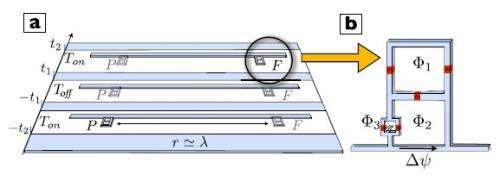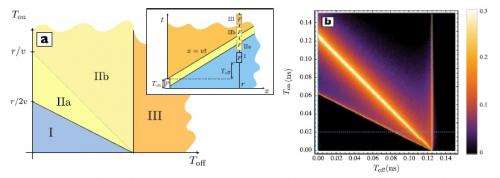July 30, 2012 feature
Qubits that never interact could exhibit past-future entanglement

(Phys.org) -- Typically, for two particles to become entangled, they must first physically interact. Then when the particles are physically separated and still share the same quantum state, they are considered to be entangled. But in a new study, physicists have investigated a new twist on entanglement in which two qubits become entangled with each other even though they never physically interact.
The physicists, Carlos Sabín, Borja Peropadre, Marco del Rey, and Eduardo Martín-Martínez at the Institute of Fundamental Physics at the Spanish National Research Council (CSIC) in Madrid (Sabín is now at the University of Nottingham in the UK, and Martin-Martinez is now at the University of Waterloo in Ontario, Canada), have published a paper on this new kind of entanglement in a recent issue of Physical Review Letters.
“We show that it is possible in a real experiment to entangle two systems that neither interact with each other nor interact with a common resource at the same time, and without the need of measurements,” Sabín told Phys.org. “The trick is to use the correlations between different times – between past and future – contained in the vacuum of a quantum field.”
In quantum theory, the quantum field is the system that contains all particles that are too small to be described classically. Although no particles exist in the vacuum region of a quantum field, physicists have known since the 1970s that this vacuum contains quantum correlations, or entanglement.

“The vacuum is globally nothing, but locally is roughly like a cloud consisting of bunches of pairs of particles that die too fast to be detected,” Sabín said. “In quantum field theory, these are called quantum fluctuations. These quantum fluctuations are correlated if we consider different regions of space, and different regions of time as well.”
If this vacuum entanglement could be extracted from the vacuum and transferred to actual particles, it could become more than just an odd quantum property and potentially serve as a useful resource for quantum information applications. But experimentally realizing the extraction of vacuum entanglement has been very difficult.
In the current study, the physicists have proposed an experiment based on circuit quantum electrodynamics (QED) that is fully within reach of current technologies. They describe a set-up that involves a pair of superconducting qubits, P and F, with qubit P connected to a quantum field vacuum by a transmission line. During the first time interval, which the scientists call the past, P interacts with the field. Then P is quickly decoupled from the field for the second time interval. Finally, F is coupled to the field for a time interval called the future. Even though P and F never interact with the field at the same time or with each other at all, F’s interactions with the field cause it to become entangled with P. The physicists call this correlation “past-future entanglement.”
To ensure that the entanglement isn’t caused by classical means, the physicists could configure the set-up so that the exchange of photons between the qubits is forbidden. In this case, the degree of entanglement depends on the spatial distance between the qubits. Further, the scientists could show that, even when allowing for a certain probability of photon exchange, the only correlations between the qubits are quantum, not classical.
“Qubit F interacts with the vacuum quantum fluctuations that are correlated with the vacuum quantum fluctuations that qubit P interacted with in the past,” Sabín said. “It's like if the qubits were exchanging ‘virtual’ – as opposed to real – photons, these undetectable particles propagating faster than light that are usually employed in quantum field theory to illuminate the computations.”
Controlling this novel kind of entanglement could lead to interesting applications, perhaps the most exciting of which is a quantum memory. Two qubits that share past-future entanglement could be used to create a device that teleports a quantum state in time. In other words, the state of qubit P could be transmitted to the future in the form of qubit F without being transmitted during the time interval when neither qubit is coupled to the field. Although quantum teleportation has already been experimentally realized, this scheme would offer an alternative with the potential for high fidelity.
In the future, the physicists hope that experimentalists in the field of superconducting circuits will perform the experiment to confirm the existence of past-future entanglement.
“We feel that these setups with superconducting qubits and transmission lines are very convenient for experiments related to fundamental questions in quantum mechanics and quantum field theory,” Sabín said.
More information: Carlos Sabín, et al. “Extracting Past-Future Vacuum Correlations Using Circuit QED.” PRL 109, 033602 (2012). DOI: 10.1103/PhysRevLett.109.033602
Journal information: Physical Review Letters
Copyright 2012 Phys.org
All rights reserved. This material may not be published, broadcast, rewritten or redistributed in whole or part without the express written permission of PhysOrg.com.
















